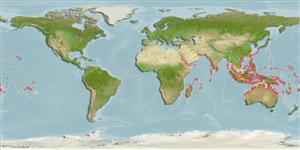Common names from other countries
Environment: milieu / climate zone / depth range / distribution range
экология
морской ассоциированный с рифами; немигрирующий; пределы глубины 0 - 30 m (Ref. 37816). Tropical; 30°N - 30°S, 30°E - 139°W
Indo-Pacific: Red Sea and East Africa to French Polynesia, north to the Ryukyu and Ogasawara islands, south to Queensland, Australia.
Length at first maturity / Size / Вес / Возраст
Maturity: Lm ?, range 24 - ? cm
Max length : 40.0 cm SL самец/пол неопределен; (Ref. 3503); common length : 27.0 cm TL самец/пол неопределен; (Ref. 5450); наибольший вес (опубликованные данные): 2.4 kg (Ref. 11441)
колючие лучи спинного плавника (общее число) : 12 - 14; членистые (мягкие) лучи спинного плавника (общее число) : 5 - 7; колючие лучи анального плавника: 3; членистые (мягкие) лучи анального плавника: 5 - 6. Colors matching surroundings and extremely well-camouflaged (Ref. 48635). Pelvic and anal fins spines are similarly developed. 12-14 stout grooved spines, each with a large venom sack at its base (Ref. 37816).
Most widespread stonefish (Ref. 4313). Found on sandy or rubble areas of reef flats and shallow lagoons and in small pools during low tide well camouflaged among the substrate and sometimes even covered with algae (Ref. 5213, 5503). Solitary species (Ref. 37816). Feeds on fishes and crustaceans. The dorsal fin has 2 grooves serving as seringes of venom; their stings are excruciatingly painful and can occasionally be fatal. A serum exists which is effective if applied immediately after the infliction. World's most venomous fish (Ref. 37816). Uncommon in markets. In Hong Kong live fish markets (Ref. 27253). Also Ref. 57406.
Life cycle and mating behavior
Maturities | размножение | Spawnings | Egg(s) | Fecundities | личинки
Poss, S.G. and K.V. Rama Rao, 1984. Scorpaenidae. In W. Fischer and G. Bianchi (eds.) FAO species identification sheets for fishery purposes. Western Indian Ocean (Fishing Area 51). Vol. 4. FAO, Rome. pag. var. (Ref. 3503)
Статус Красного Списка МСОП (Ref. 130435)
CITES (Ref. 128078)
Not Evaluated
Использование человеком
рыболовство: не имеет хозяйственного значения; аквариум: коммерческий
дополнительная информация
инструменты
Специальные отчеты
Скачать в формате XML
ресурсы в Интернет
Estimates based on models
Preferred temperature (Ref.
115969): 24.9 - 29.3, mean 28.3 (based on 3300 cells).
Phylogenetic diversity index (Ref.
82804): PD
50 = 0.5312 [Uniqueness, from 0.5 = low to 2.0 = high].
Bayesian length-weight: a=0.01622 (0.00609 - 0.04318), b=3.05 (2.82 - 3.28), in cm Total Length, based on LWR estimates for this (Sub)family-body shape (Ref.
93245).
Trophic level (Ref.
69278): 4.4 ±0.77 se; based on food items.
устойчивость к внешним воздействиям (Ref.
120179): низкий, минимальное время удвоения популяции 4.5-14 лет (Preliminary K or Fecundity.).
Fishing Vulnerability (Ref.
59153): Moderate vulnerability (39 of 100).
